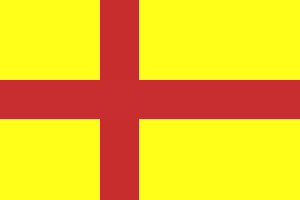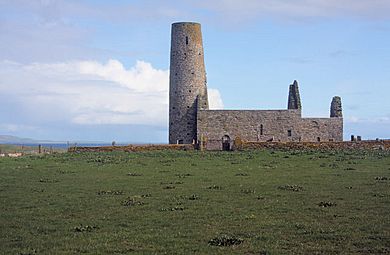Magnus Erlendsson, Earl of Orkney facts for kids
Quick facts for kids
Magnus Erlendsson
|
|
|---|---|
| Earl of Orkney | |

St. Magnus statue in Nidaros Cathedral (Trondheim, Norway)
|
|
| Tenure | 1106–1117 |
| Other names | Magnus the Martyr |
| Born | 1080 |
| Died | 16 April 1117 Egilsay, Orkney Islands, Norway |
| Parents | Erlend Thorfinnsson and Thora, daughter of Sumarlidi Ospaksson |
| Saint Magnus of Orkney |
|
|---|---|
| Venerated in |
|
| Canonized | 11 July 1898 (cultus confirmation) by Pope Leo XIII |
| Feast | 16 April |
| Attributes | Viking clothing, axe |
| Patronage | Orkney |
Saint Magnus Erlendsson, also known as Magnus the Martyr, was an important leader called the Earl of Orkney. He held this title from 1106 to about 1117.
Magnus's grandparents were Earl Thorfinn and Ingibiorg Finnsdottir. They had twin sons, Erlend and Paul. Through his grandmother Ingibiorg, Magnus's family was related to the Norwegian Kings Olav II and Harald II.
Contents
Biography of Saint Magnus
Magnus's Family Background
Magnus was the first son of Erlend Thorfinnsson. His father was an Earl of Orkney, sharing power with his brother Paal. Magnus's mother was Thora, daughter of Sumarlidi Ospaksson.
Magnus had another brother named Aerling, and two sisters, Gunnhild and Cecilia. His father Erlend also had a daughter named Jaddvor.
At first, Earl Erlend and Earl Paal got along well. But as their children grew up, problems started. Paal's son, Haakon Paulsson, and Erlend's son, Aerling Erlendsson, became rivals. Both Haakon and Aerling were described as talented but also proud and quick to argue. Magnus, however, was known as "a quiet sort of man."
Haakon felt he was the most important cousin and wanted to be the leader. But Aerling would not give in. Their fathers tried to make peace, but they both favored their own sons. Eventually, the earldom was split into two separate areas.
Norway's Influence on Orkney
Haakon Paalsson traveled to Scandinavia and stayed with his relative, Magnus Barefoot, the King of Norway. While there, Haakon heard that his father Paal had given much control of Orkney to Earl Erlend and his sons. After a long time of peace, the people of Orkney did not want Haakon to return.
So, Haakon asked King Magnus for help to get the earldom for himself. He suggested that the king take direct control of Orkney. King Magnus agreed. In 1098, he launched a big military campaign, bringing his 8-year-old son Sigurd with him.
However, King Magnus had his own plans. He took over the islands and removed both Erlend and Paal Thorfinsson. They were sent to Norway as prisoners. Haakon and his cousins, Magnus and Aerling Erlendsson, were taken by King Magnus as hostages. Sigurd was then made the new Earl of Orkney. Sigurd's rule was helped by a council, which included Haakon.
From Orkney, King Magnus then led a raiding trip along the west coast of Scotland and into the Irish Sea.
Battle of Menai Straits
The Orkneyinga Saga (a historical story) says that Magnus was known for being religious and gentle. The Norwegians saw this as being cowardly. He refused to fight in a Viking raid in Anglesey, Wales, because of his strong religious beliefs. Instead, he stayed on the ship during the Battle of Menai Straits, singing religious songs. His brother Aerling died while fighting with King Magnus, either in that battle or in Ulster.
Magnus had to find safety in Scotland. But he returned to Orkney in 1105 and argued with his cousin Haakon over who should rule. When they could not agree, Magnus asked King Eystein I of Norway for help. The king gave him the earldom of Orkney. Magnus and Haakon then ruled together peacefully until 1114.
Magnus's Execution
Eventually, the followers of the two earls started fighting. Both sides met at the Thing (a public meeting or assembly) on the Orkney mainland, ready for battle. They managed to make peace. The earls agreed to meet on the island of Egilsay at Easter, each bringing only two ships.
Magnus arrived with his two ships. But Haakon unfairly showed up with eight ships. Magnus hid in the island's church overnight. The next day, he was captured. He offered to go into exile or prison. However, a group of chieftains, tired of having two earls, insisted that one must die.
Haakon's flag-bearer, Ofeigr, refused to kill Magnus. An angry Haakon then made his cook, Lifolf, kill Magnus by hitting him on the head with an axe. It is said that Magnus first prayed for the people who were about to kill him.
According to the sagas, Magnus was killed after Easter, on April 16. The year is often given as 1115, but this is not possible because April 16 was before Easter that year. Most experts now believe he died in 1117. His 900th anniversary was remembered in his Cathedral in Kirkwall, Orkney, in 2017.
Magnus's Burial and Miracles
Magnus was first buried where he died. His legend says that the rocky ground around his grave suddenly became a green field. Later, Magnus's mother, Thora, asked Haakon if she could bury him in a church. Haakon agreed, and Magnus was then buried at Christchurch in Birsay.
Many reports of miracles and healings happened at his grave. William the Old, the Bishop of Orkney, warned people that it was "heresy to go about with such tales." He was then struck blind at his church. But he got his sight back after praying at Magnus's grave. This happened not long after he visited Norway.
In 1136, Bishop William of Orkney declared the murdered Earl Magnus a saint. He became Saint Magnus. It is believed that St Magnus Church, Egilsay was built on the island soon after, near where Magnus was thought to be murdered. This church might have replaced an older one that was already there.
Magnus's nephew, Rognvald Kali Kolsson, claimed the Earldom of Orkney. His father, Kol, told him to promise the islanders that he would "build a stone church at Kirkwall" to honor his uncle, the Holy Earl. This church became St Magnus Cathedral, Kirkwall.
When the cathedral, which started being built in 1137, was ready, Saint Magnus's bones were moved there. On March 31, 1919, during restoration work, a hidden space was found in a column. It contained a box with bones, including a damaged skull. These are believed to be the bones of Saint Magnus. The remains were put back in the pillar in 1926, and the spot is marked with a cross.
Magnus in Books and Art
Saint Magnus is the main character in the novel Magnus by Orcadian author George Mackay Brown, published in 1973. He is also featured in St Magnus, Earl of Orkney by John Mooney. A novel for young adults called "Saint Magnus, the Last Viking" by Susan Peek was published in 2016.
In 1977, Peter Maxwell Davies wrote a short opera called The Martyrdom of St Magnus, based on Mackay Brown's novel. In 1989, English composer Clive Strutt wrote THREE HYMNS In Praise of Saint Magnus. The song "Higher Ground" by Rasmussen, which represented Denmark at the Eurovision Song Contest 2018, is also based on the story of Magnus Erlendsson.
Places Named After Saint Magnus
In the Faroes, the St Magnus Cathedral, Kirkjubøur was built around 1300 A.D. It is believed the church was used for services, and bones thought to be Saint Magnus's were found there in 1905. Kirkjubøur is a very important historical site in the Faroes.
There are 21 churches in Europe dedicated to St Magnus. One of them is St Magnus the Martyr, a church near the north end of London Bridge in London. It was first built in the 12th century and rebuilt by Christopher Wren in the 17th century.
Other places and groups named after Saint Magnus include:
- TS Magnus, part of the Australian Navy Cadets
- Magnus House, a day house at the Anglican Church Grammar School in Brisbane.
- Anglican Church Grammar School, which has Saint Magnus as its Patron Saint.



